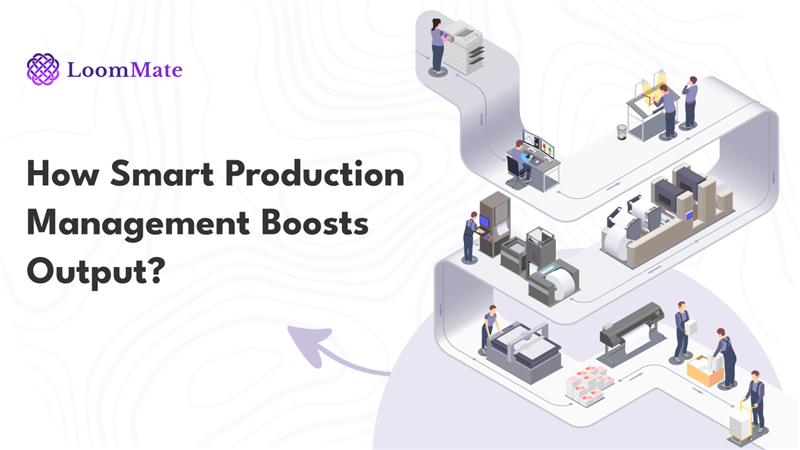At the end of it all, more output, fewer mistakes, and lower costs are businesses’ targets. If production is done manually or, for that matter, across systems from here and there, then it becomes quite difficult to attain that very goal. Delays occur, raw material gets wasted, and deadlines are missed.
Smart Production Management unfolds at this juncture. When placed within the right atmosphere and given the right ambiance, all areas of production can be handled with efficiency that directly reflects in output levels.
What is Smart Production Management?
Smart production management is the process of using technology, automation, and real-time data to plan, track, and control the production process. Instead of working without knowledge or with late reports, managers now get an instant update on what is happening on the factory floor.
It comprises:
- Digital Tracking
- Automated Reports
- Clear Scheduling
- Real-Time Communication
In other words, fewer bottlenecks mean a shorter turnaround and better results.
1. Clear Planning Reduces Delays
Delays creep into a large number of works in companies because the work is not planned at all. Orders get mixed up, raw materials arrive late, or staff isn’t there when needed.
Smart planning software allows you to:
- Schedule production stepwise
- Assign manpower and machines as required
- Track the requirements of raw materials
- Prevent clashes when two or more orders are scheduled simultaneously
With proper planning, delays reduce, and production goes up.
2. Real-Time Tracking Stops Bottlenecks
Imagine waiting until the end of the day to find out that a particular machine had broken down in the morning. The company has lost some hours of production already.
With smart production tracking:
- Updates are registered by the managers in real time.
- Any downtime of machines is reported instantly.
- Work can be reassigned at the earliest.
- Small issues are addressed before they become major ones.
This real-time view guarantees a smooth production flow.
Follow Us on: Facebook | Instagram | Pinterest | LinkedIn | Twitter
3. Better Use of Raw Materials
Wasted raw materials eat away profits. Whether it is yarn for textiles, steel for manufacturing, or chemicals for processing-industrial tracking of raw materials is frequently responsible for too little or too much use.
Smart systems help:
- By keeping records of material usage automatically.
- By forecasting requirements.
- By issuing warnings when stocks approach a minimum
- By preventing over-purchasing
The end result: less wastage, and better utilization of resources.
4. Improved Worker Productivity
When workers know their exact tasks and deadlines, they are able to perform well. Confusion, double work, or unclear instructions reduce efficiency.
Smart production management ensures:
- Tasks are assigned with clear instructions
- Everyone knows his/her role
- On-track performance is measured
- Need of training is identified
With a proper guide, workers can improve their productivity and output.
5. Faster Communication
Communication between any two or many departments is slow in many factories. The purchase department does not update production, Smart Production Management department does not update sales, and information reaches managers a long delayed time.
With smart systems:
- Departments instantly share updates.
- The sales team is able to know production status in real time.
- Managers get daily summaries automatically.
- Decisions get taken faster.
If communication flows, no production halts.
6. Fewer Errors in Orders
The manual systems involve errors like these:
- Producing the wrong design or size
- Not including urgent orders
- Shipping incomplete products
Smart production management places orders in a common place and links them to stock and deadlines. Each department works on the same data, which reduces errors and reworks.
7. Timely Delivery to Customers
On-time delivery is the key to customer satisfaction. Late deliveries hurt reputations-they are lost orders.
With smart tracking:
- Managers observe orders on schedule
- Deadlines are automatically alerted
- Production becomes adjustable for priority orders
Customers have realistic delivery dates
Faster and reliable deliverance directly results in output and customer satisfaction.
More Updates For: Why Order Management Software is Vital for Growing Textile Brands
8. Accurate Reporting for Better Decisions
Smart Production Management Managers need reliable reports to make correct decisions. Yet manual reports take time and some time inaccuracy creeps in.
Smart systems provide:
- Daily production reports
- Cost analysis per unit
- Machine performance statistics
- Worker productivity reports
Managers consult these reports on weak spots to decide how to strengthen their decision making for future growth.
9. Reduced Overtime Costs
When work is poorly scheduled, overtime is the order of the day, and that means paying for more time. Workers lose morale, on top of it.
Smart production management:
- Cleans out last-minute run around
- Enables better use of time within normal working hours
- Lowers need for overtime pay
Thus putting a stop to expenditure but keeping outputs intact.
10. Scalability for Growth
Manual systems will stay behind as growing businesses. Smart production management grows with you.
You will be able to get:
- More orders without confusion.
- Larger teams without chaos.
- Bigger stock levels without errors.
And because the system scales, your business can be able to expand without hitting production roadblocks.
Conclusion
At LoomMate, smart production management is about intelligent working, rather than just software. When a business knows what to plan, track work in real-time, make better use of materials, and fast communication, its output is vastly increased.
Whether you are looking at a textile unit, small factory, or large manufacturing setup, these benefits are the same: less waste, less delays, and more productivity.
The ones that embrace smart production today will be leading their industries tomorrow.
FAQs
Q1. Is smart production management only for big factories?
Small and medium businesses, too, can make use of it. Tools can be scaled to measure any size.
Q2. Do I need new machines for Smart Production Management?
Not necessarily. Many can monitor and manage production using existing machines and simple digital setups.
Q3. How does it reduce costs?
By cutting delays, reducing raw material waste, minimizing overtime, and avoiding errors, overall costs go down.
Q4. Will it take long to train staff?
Modern production management systems are user-friendly. Most workers learn the basics within a few days.
Q5. What’s the biggest advantage of going smart?
The biggest gain is higher output in less time—without increasing costs.



